An Experimental Study on Low-Cycle Fatigue Crack Initiation Life Prediction of Powder Superalloy FGH96 Based on the Manson-Coffin and Damage Mechanics Methods
Abstract
:1. Introduction
2. Basic Principles
2.1. Basic Principle of Manson-Coffin Theory
2.2. Basic Principle of Damage Mechanics
3. Manson-Coffin Life Prediction Model
3.1. Establishment of Manson-Coffin Life Prediction Model for Powder Superalloys
3.2. Applicability Analysis of Manson-Coffin Model
4. Prediction Model Based on Damage Mechanics
4.1. Establishment of Life Prediction Model Based on Damage Mechanics
4.2. Applicability Analysis of Model Based on Damage Mechanics
4.2.1. Life Prediction of Standard Parts without Inclusions
4.2.2. Life Prediction of Powder Superalloy Containing Inclusions
5. Conclusions
- The powder superalloy FGH96 has obvious high strength and low plasticity. When using the Manson-Coffin equation to establish the fatigue life prediction model, in the fatigue test of FGH96 standard parts, the plastic deformation of the specimen is extremely small and the data dispersion is large, which leads to the poor regression of the experimental data in the plastic strain parameter fitting.
- The existence of inclusion leads to the obvious stress concentration in the stress field around the inclusions during the loading process, which is the main reason for the decrease of low cycle fatigue life of powder superalloy caused by inclusion. The Manson-coffin equation obviously cannot take this kind of micro defect into account, also, the fatigue crack initiation information of powder superalloy FGH96 containing inclusion cannot be reflected.
- When a smooth non-destructive specimen is used for data fitting, there are certain errors in the damage parameters obtained, which introduced an error for the life prediction model.
- When the finite element model is established for numerical calculation, the matrix material and inclusions were simplified to 2D plane model, which reduces the number of degrees of freedom of nodes, and cannot well simulate the material flow of the specimen under load in the actual situation.
- Only two sizes of inclusion were used during the modeling of inclusions, which cannot reflect the actual shape of inclusions well. Inclusions may have more significant characteristics in another dimension than the model size data, which leads to errors between experimental life and predicted life.
Author Contributions
Funding
Acknowledgments
Conflicts of Interest
Appendix A
| Strain Range 0.95% | |||||||||
| No. | Max Strain εmax | Δεe/2 | Δεp/2 | Cycle Times Nf | No. | Max Strain εmax | Δεe/2 | Δεp/2 | Cycle Times Nf |
| 1 | 0.01001 | 4.68 × 10−3 | 7.72 × 10−5 | 2141 | 16 | 0.01 | 4.76 × 10−3 | −1.29 × 10−5 | 5210 |
| 2 | 0.01 | 4.67 × 10−3 | 7.47 × 10−5 | 4135 | 17 | 0.01 | 4.83 × 10−3 | −7.73 × 10−5 | 4756 |
| 3 | 0.01 | 4.64 × 10−3 | 1.11 × 10−4 | 6268 | 18 | 0.01 | 4.90 × 10−3 | −1.42 × 10−4 | 1937 |
| 4 | 0.01 | 4.68 × 10−3 | 6.96 × 10−5 | 5232 | 19 | 0.01 | 4.82 × 10−3 | −7.47 × 10−5 | 2939 |
| 5 | 0.01 | 4.72 × 10−3 | 3.35 × 10−5 | 4610 | 20 | 0.00991 | 4.85 × 10−3 | −1.88 × 10−4 | 2880 |
| 6 | 0.01 | 4.74 × 10−3 | 1.55 × 10−7 | 5333 | 21 | 0.01 | 4.90 × 10−3 | −1.64 × 10−4 | 2770 |
| 7 | 0.01 | 4.69 × 10−3 | 5.93 × 10−5 | 4732 | 22 | 0.01 | 4.82 × 10−3 | −7.22 × 10−5 | 3700 |
| 8 | 0.01001 | 4.71 × 10−3 | 4.11 × 10−5 | 7146 | 23 | 0.01 | 4.62 × 10−3 | 1.26 × 10−4 | 4988 |
| 9 | 0.01 | 4.69 × 10−3 | 6.19 × 10−5 | 6535 | 24 | 0.01 | 4.82 × 10−3 | −6.70 × 10−5 | 5842 |
| 10 | 0.00999 | 4.75 × 10−3 | −5.00 × 10−6 | 2114 | 25 | 0.01 | 4.79 × 10−3 | −3.87 × 10−5 | 4745 |
| 11 | 0.01 | 4.69 × 10−3 | 5.69 × 10−5 | 5267 | 26 | 0.01 | 4.93 × 10−3 | −1.75 × 10−4 | 4490 |
| 12 | 0.01 | 4.79 × 10−3 | −3.61 × 10−5 | 6724 | 27 | 0.01 | 4.65 × 10−3 | 1.00 × 10−4 | 5820 |
| 13 | 0.01 | 4.82 × 10−3 | −7.22 × 10−5 | 4560 | 28 | 0.01001 | 4.79 × 10−3 | −3.11 × 10−5 | 4823 |
| 14 | 0.01 | 4.90 × 10−3 | −1.49 × 10−4 | 3142 | 29 | 0.01001 | 4.59 × 10−3 | 1.65 × 10−4 | 6235 |
| 15 | 0.01 | 4.74 × 10−3 | 1.03 × 10−5 | 5210 | |||||
| Strain range 0.846% | |||||||||
| No. | Max strain εmax | Δεe/2 | Δεp/2 | Cycle times Nf | No. | Max strain εmax | Δεe/2 | Δεp/2 | Cycle times Nf |
| 30 | 0.0089 | 4.30 × 10−3 | −7.14 × 10−5 | 8301 | 53 | 0.0089 | 2.53 × 10−4 | 3.97 × 10−3 | 7427 |
| 31 | 0.0089 | 4.35 × 10−3 | −1.23 × 10−4 | 10,454 | 54 | 0.0089 | 4.32 × 10−3 | −9.72 × 10−5 | 7771 |
| 32 | 0.0089 | 4.32 × 10−3 | −9.20 × 10−5 | 11,376 | 55 | 0.0089 | 4.32 × 10−3 | −9.46 × 10−5 | 10,289 |
| 33 | 0.0089 | 4.17 × 10−3 | 5.75 × 10−5 | 13,500 | 56 | 0.0089 | 4.28 × 10−3 | −5.85 × 10−5 | 10,877 |
| 34 | 0.0089 | 4.22 × 10−3 | 5.93 × 10−6 | 12,219 | 57 | 0.0089 | 4.27 × 10−3 | −4.56 × 10−5 | 5911 |
| 35 | 0.0089 | 4.22 × 10−3 | 8.51 × 10−6 | 9285 | 58 | 0.0089 | 4.38 × 10−3 | −1.51 × 10−4 | 6276 |
| 36 | 0.0089 | 4.14 × 10−3 | 8.32 × 10−5 | 12,504 | 59 | 0.0089 | 4.27 × 10−3 | −4.56 × 10−5 | 9246 |
| 37 | 0.0089 | 4.09 × 10−3 | 1.32 × 10−4 | 9509 | 60 | 0.0089 | 4.25 × 10−3 | −2.24 × 10−5 | 13,204 |
| 38 | 0.0089 | 4.43 × 10−3 | −2.05 × 10−4 | 11,116 | 61 | 0.0089 | 4.34 × 10−3 | −1.15 × 10−4 | 12,249 |
| 39 | 0.0089 | 4.35 × 10−3 | −1.20 × 10−4 | 7962 | 62 | 0.0089 | 4.36 × 10−3 | −1.36 × 10−4 | 13,716 |
| 40 | 0.0089 | 4.32 × 10−3 | −9.46 × 10−5 | 11,518 | 63 | 0.0089 | 4.15 × 10−3 | 7.29 × 10−5 | 14,174 |
| 41 | 0.0089 | 4.27 × 10−3 | −4.05 × 10−5 | 7209 | 64 | 0.0089 | 4.30 × 10−3 | −7.40 × 10−5 | 14,856 |
| 42 | 0.0089 | 4.15 × 10−3 | 7.29 × 10−5 | 13,182 | 65 | 0.0089 | 4.16 × 10−3 | 6.01 × 10−5 | 11,188 |
| 43 | 0.0089 | 4.31 × 10−3 | −8.94 × 10−5 | 6544 | 66 | 0.0089 | 4.31 × 10−3 | −8.69 × 10−5 | 13,672 |
| 44 | 0.0089 | 4.42 × 10−3 | −1.95 × 10−4 | 12,900 | 67 | 0.0089 | 4.43 × 10−3 | −2.03 × 10−4 | 10,308 |
| 45 | 0.0089 | 4.41 × 10−3 | −1.90 × 10−4 | 11,031 | 68 | 0.0089 | 4.15 × 10−3 | 7.29 × 10−5 | 10,726 |
| 46 | 0.0089 | 4.40 × 10−3 | −1.77 × 10−4 | 6567 | 69 | 0.0089 | 4.29 × 10−3 | −6.37 × 10−5 | 17,389 |
| 47 | 0.0089 | 4.19 × 10−3 | 3.17 × 10−5 | 14,521 | 70 | 0.0089 | 4.34 × 10−3 | −1.18 × 10−4 | 10,084 |
| 48 | 0.0089 | 4.29 × 10−3 | −6.37 × 10−5 | 8125 | 71 | 0.0089 | 4.46 × 10−3 | −2.36 × 10−4 | 3568 |
| 49 | 0.0089 | 4.34 × 10−3 | −1.10 × 10−4 | 12,616 | 72 | 0.0089 | 4.43 × 10−3 | −2.00 × 10−4 | 4330 |
| 50 | 0.0089 | 4.43 × 10−3 | −2.00 × 10−4 | 9254 | 73 | 0.0089 | 4.49 × 10−3 | −2.62 × 10−4 | 6996 |
| 51 | 0.0089 | 4.21 × 10−3 | 1.11 × 10−5 | 13,550 | 74 | 0.0089 | 4.08 × 10−3 | 1.48 × 10−4 | 14,295 |
| 52 | 0.0089 | 4.34 × 10−3 | −1.15 × 10−4 | 9857 | 75 | 0.0089 | 4.19 × 10−3 | 3.43 × 10−5 | 5434 |
| Strain range 0.76% | |||||||||
| No. | Max strain εmax | Δεe/2 | Δεp/2 | Cycle times Nf | No. | Max strain εmax | Δεe/2 | Δεp/2 | Cycle times Nf |
| 76 | 0.008 | 3.85 × 10−3 | −4.79 × 10−5 | 9584 | 89 | 0.008 | 3.80× 10−3 | −9.12 × 10−6 | 8765 |
| 77 | 0.008 | 3.83 × 10−3 | −2.73 × 10−5 | 22,138 | 90 | 0.008 | 3.95× 10−3 | −1.51 × 10−4 | 11,387 |
| 78 | 0.008 | 3.84 × 10−3 | −3.51 × 10−5 | 10,633 | 91 | 0.008 | 3.87× 10−3 | −7.11 × 10−5 | 8689 |
| 79 | 0.008 | 3.85 × 10−3 | −5.55 × 10−5 | 25,297 | 92 | 0.00801 | 3.92× 10−3 | −1.13 × 10−4 | 25,615 |
| 80 | 0.008 | 3.88 × 10−3 | −8.64 × 10−5 | 11,755 | 93 | 0.00799 | 3.84× 10−3 | −5.28 × 10−5 | 10,985 |
| 81 | 0.008 | 3.82 × 10−3 | −1.70 × 10−5 | 11,522 | 94 | 0.008 | 3.84× 10−3 | −4.28 × 10−5 | 11,970 |
| 82 | 0.008 | 3.78 × 10−3 | 6.50 × 10−6 | 28,084 | 95 | 0.008 | 3.87× 10−3 | −6.10 × 10−5 | 14,817 |
| 83 | 0.008 | 3.80 × 10−3 | −4.12 × 10−6 | 15,332 | 96 | 0.008 | 3.85× 10−3 | −5.29 × 10−5 | 14,042 |
| 84 | 0.008 | 3.82 × 10−3 | −1.70 × 10−5 | 7801 | 97 | 0.008 | 3.86× 10−3 | −5.07 × 10−5 | 14,443 |
| 85 | 0.008 | 3.74 × 10−3 | 5.79 × 10−5 | 6595 | 98 | 0.008 | 3.85× 10−3 | −4.55 × 10−5 | 15,368 |
| 86 | 0.008 | 3.79 × 10−3 | 6.34 × 10−6 | 23,388 | 99 | 0.008 | 3.86× 10−3 | −5.82 × 10−5 | 11,467 |
| 87 | 0.008 | 3.85 × 10−3 | −5.31 × 10−5 | 7064 | 100 | 0.00801 | 3.90× 10−3 | −9.19 × 10−5 | 14,666 |
| 88 | 0.00799 | 3.83 × 10−3 | −3.23 × 10−5 | 9360 | |||||
| Strain range 1% | |||||||||
| No. | Max strain εmax | Δεe/2 | Δεp/2 | Cycle times Nf | No. | Max strain εmax | Δεe/2 | Δεp/2 | Cycle times Nf |
| 101 | 0.01052 | 5.05 × 10−3 | −4.64 × 10−5 | 3663 | 114 | 0.01052 | 4.89 × 10−3 | 1.06 × 10−4 | 5166 |
| 102 | 0.01052 | 4.98 × 10−3 | 1.55 × 10−5 | 3693 | 115 | 0.01053 | 5.02 × 10−3 | −1.82 × 10−5 | 4649 |
| 103 | 0.01052 | 4.90 × 10−3 | 1.08 × 10−4 | 3768 | 116 | 0.01052 | 5.00 × 10−3 | 2.58 × 10−6 | 3742 |
| 104 | 0.01052 | 5.13 × 10−3 | −1.29 × 10−4 | 3255 | 117 | 0.01052 | 4.99 × 10−3 | 1.29 × 10−5 | 3916 |
| 105 | 0.01052 | 4.93 × 10−3 | 6.96 × 10−5 | 3935 | 118 | 0.01052 | 4.99 × 10−3 | 5.16 × 10−6 | 3654 |
| 106 | 0.01052 | 4.99 × 10−3 | 1.29 × 10−5 | 3564 | 119 | 0.01052 | 5.01 × 10−3 | −5.16 × 10−6 | 4196 |
| 107 | 0.01052 | 5.04 × 10−3 | −3.87 × 10−5 | 3449 | 120 | 0.01052 | 4.92 × 10−3 | 7.73 × 10−5 | 4217 |
| 108 | 0.01052 | 5.01 × 10−3 | −7.73 × 10−6 | 3334 | 121 | 0.01052 | 4.99 × 10−3 | 7.89 × 10−6 | 4149 |
| 109 | 0.01052 | 4.87 × 10−3 | 1.34 × 10−4 | 3472 | 122 | 0.01052 | 5.02 × 10−3 | −1.56 × 10−5 | 3475 |
| 110 | 0.01052 | 5.00 × 10−3 | 0.00 | 3108 | 123 | 0.01053 | 4.93 × 10−3 | 7.70 × 10−5 | 3843 |
| 111 | 0.01052 | 4.91 × 10−3 | 8.52 × 10−5 | 3050 | 124 | 0.01052 | 5.06 × 10−3 | −6.17 × 10−5 | 4051 |
| 112 | 0.01051 | 4.86 × 10−3 | 1.34 × 10−4 | 4938 | 125 | 0.01052 | 5.05 × 10−3 | −4.40 × 10−5 | 2883 |
| 113 | 0.01053 | 5.03 × 10−3 | −2.85 × 10−5 | 3589 | |||||
Appendix B
| Strain Range 0.65% | |||||||||
| No. | Max Strain εmax | Δεe/2 | Δεp/2 | Cycle Times Nf | No. | Max Strain εmax | Δεe/2 | Δεp/2 | Cycle Times Nf |
| 1 | 0.0081 | 3.16 × 10−3 | 9.02 × 10−5 | 9153 | 14 | 0.0081 | 3.26 × 10−3 | −1.53 × 10−5 | 22,531 |
| 2 | 0.0081 | 3.20 × 10−3 | 5.40 × 10−5 | 7562 | 15 | 0.00811 | 3.30 × 10−3 | −5.41 × 10−5 | 24,563 |
| 3 | 0.0081 | 3.20 × 10−3 | 4.90 × 10−5 | 10,603 | 16 | 0.00811 | 3.24 × 10−3 | 2.73 × 10−6 | 60,078 |
| 4 | 0.0081 | 3.15 × 10−3 | 9.04 × 10−5 | 15,806 | 17 | 0.0081 | 3.27 × 10−3 | −1.80 × 10−5 | 59,511 |
| 5 | 0.0081 | 3.27 × 10−3 | −1.80 × 10−5 | 9394 | 18 | 0.0081 | 3.38 × 10−3 | −1.34 × 10−4 | 49,963 |
| 6 | 0.0081 | 3.24 × 10−3 | 5.16 × 10−6 | 9855 | 19 | 0.00811 | 3.31 × 10−3 | −5.69 × 10−5 | 118,213 |
| 7 | 0.0081 | 3.42 × 10−3 | −1.78 × 10−4 | 12,295 | 20 | 0.0081 | 3.31 × 10−3 | −6.19 × 10−5 | 9280 |
| 8 | 0.0081 | 3.32 × 10−3 | −6.70 × 10−5 | 22,738 | 21 | 0.0081 | 3.28 × 10−3 | −3.35 × 10−5 | 10,970 |
| 9 | 0.0081 | 3.20 × 10−3 | 5.41 × 10−5 | 7242 | 22 | 0.0081 | 3.17 × 10−3 | 8.49 × 10−5 | 61,160 |
| 10 | 0.0081 | 3.04 × 10−3 | 2.11 × 10−4 | 71,233 | 23 | 0.0081 | 3.28 × 10−3 | −3.09 × 10−5 | 7497 |
| 11 | 0.0081 | 3.26 × 10−3 | −1.03 × 10−5 | 63,615 | 24 | 0.0081 | 3.32 × 10−3 | −7.97 × 10−5 | 63,512 |
| 12 | 0.0081 | 3.12 × 10−3 | 1.39 × 10−4 | 10,415 | 25 | 0.0081 | 3.26 × 10−3 | −1.03 × 10−5 | 71,581 |
| 13 | 0.0081 | 3.28 × 10−3 | −2.35 × 10−5 | 28,211 | 26 | 0.0081 | 3.29 × 10−3 | −4.11 × 10−5 | 224,817 |
| Strain range 0.751% | |||||||||
| No. | Max strain εmax | Δεe/2 | Δεp/2 | Cycle times Nf | No. | Max strain εmax | Δεe/2 | Δεp/2 | Cycle times Nf |
| 27 | 0.0094 | 3.76 × 10−3 | −3.09 × 10−7 | 90,839 | 42 | 0.0094 | 3.79 × 10−3 | −3.62 × 10−5 | 6293 |
| 28 | 0.0094 | 3.70 × 10−3 | 6.91 × 10−5 | 19,729 | 43 | 0.0094 | 3.88 × 10−3 | −1.11 × 10−4 | 7231 |
| 29 | 0.0094 | 3.80 × 10−3 | −4.15 × 10−5 | 18,217 | 44 | 0.0094 | 3.75 × 10−3 | 1.26 × 10−5 | 6205 |
| 30 | 0.0094 | 3.65 × 10−3 | 1.08 × 10−4 | 7080 | 45 | 0.00939 | 3.68 × 10−3 | 6.96 × 10−5 | 7811 |
| 31 | 0.0094 | 3.76 × 10−3 | 4.69 × 10−6 | 11,246 | 46 | 0.0094 | 3.76 × 10−3 | −1.79 × 10−5 | 9815 |
| 32 | 0.0094 | 3.71 × 10−3 | 4.37 × 10−5 | 6353 | 47 | 0.00939 | 3.73 × 10−3 | 8.04 × 10−6 | 7546 |
| 33 | 0.0094 | 3.71 × 10−3 | 4.12 × 10−5 | 44,595 | 48 | 0.0094 | 3.74 × 10−3 | 1.55 × 10−7 | 8629 |
| 34 | 0.0094 | 3.56 × 10−3 | 1.86 × 10−4 | 10,614 | 49 | 0.0094 | 3.68 × 10−3 | 8.46 × 10−5 | 9986 |
| 35 | 0.0094 | 3.74 × 10−3 | 7.73 × 10−6 | 35,915 | 50 | 0.0094 | 3.78 × 10−3 | −2.59 × 10−5 | 3910 |
| 36 | 0.0094 | 3.77 × 10−3 | −2.32 × 10−5 | 8402 | 51 | 0.0094 | 3.73 × 10−3 | 3.82 × 10−5 | 10,397 |
| 37 | 0.0094 | 3.63 × 10−3 | 1.21 × 10−4 | 6865 | 52 | 0.00941 | 3.69 × 10−3 | 7.19 × 10−5 | 6244 |
| 38 | 0.00941 | 3.79 × 10−3 | −3.37 × 10−5 | 8648 | 53 | 0.00939 | 3.87 × 10−3 | −1.31 × 10−4 | 7540 |
| 39 | 0.00939 | 3.77 × 10−3 | −3.56 × 10−5 | 8399 | 54 | 0.0094 | 3.78 × 10−3 | −2.84 × 10−5 | 6365 |
| 40 | 0.0094 | 3.73 × 10−3 | 1.30 × 10−5 | 7651 | 55 | 0.0094 | 3.76 × 10−3 | −5.31 × 10−6 | 10,565 |
| 41 | 0.00941 | 3.66 × 10−3 | 1.10 × 10−4 | 5053 | 56 | 0.0094 | 3.88 × 10−3 | −1.21 × 10−4 | 7643 |
| Strain range 0.849% | |||||||||
| No. | Max strain εmax | Δεe/2 | Δεp/2 | Cycle times Nf | No. | Max strain εmax | Δεe/2 | Δεp/2 | Cycle times Nf |
| 57 | 0.0106 | 4.16 × 10−3 | 0.000092629 | 4439 | 72 | 0.0106 | 4.33 × 10−3 | −0.000077320 | 5476 |
| 58 | 0.0106 | 4.26 × 10−3 | −0.000010309 | 5961 | 73 | 0.0106 | 4.23 × 10−3 | 0.000023196 | 7360 |
| 59 | 0.0106 | 4.27 × 10−3 | −0.000028196 | 6209 | 74 | 0.0106 | 4.24 × 10−3 | 0.000000155 | 6188 |
| 60 | 0.0106 | 4.25 × 10−3 | −0.000005000 | 6176 | 75 | 0.0106 | 4.30 × 10−3 | −0.000051546 | 4952 |
| 61 | 0.0106 | 4.31 × 10−3 | −0.000061701 | 4927 | 76 | 0.0106 | 4.22 × 10−3 | 0.000023505 | 6504 |
| 62 | 0.0106 | 4.26 × 10−3 | −0.000017732 | 7330 | 77 | 0.0106 | 4.29 × 10−3 | −0.000046237 | 5079 |
| 63 | 0.0106 | 4.32 × 10−3 | −0.000067010 | 5746 | 78 | 0.01061 | 4.26 × 10−3 | −0.000010309 | 6999 |
| 64 | 0.0106 | 4.28 × 10−3 | −0.000033351 | 5462 | 79 | 0.0106 | 4.23 × 10−3 | 0.000008041 | 6517 |
| 65 | 0.0106 | 4.30 × 10−3 | −0.000053969 | 6241 | 80 | 0.01059 | 4.17 × 10−3 | 0.000077320 | 6038 |
| 66 | 0.0106 | 4.19 × 10−3 | 0.000054278 | 7242 | 81 | 0.0106 | 4.08 × 10−3 | 0.000172680 | 9946 |
| 67 | 0.0106 | 4.23 × 10−3 | 0.000023196 | 5468 | 82 | 0.0106 | 4.18 × 10−3 | 0.000069588 | 5139 |
| 68 | 0.0106 | 4.18 × 10−3 | 0.000062010 | 4971 | 83 | 0.0106 | 4.35 × 10−3 | −0.000090361 | 3724 |
| 69 | 0.0106 | 4.25 × 10−3 | −0.000007577 | 5065 | 84 | 0.01061 | 4.10 × 10−3 | 0.000151907 | 10,289 |
| 70 | 0.0106 | 4.07 × 10−3 | 0.000165258 | 5614 | 85 | 0.0106 | 4.27 × 10−3 | −0.000035619 | 5481 |
| 71 | 0.01061 | 4.14 × 10−3 | 0.000103402 | 6652 | 86 | 0.0106 | 4.22 × 10−3 | 0.000033505 | 6590 |
References
- Shi, C.X.; Zhong, Z.Y. Development and innovation of superalloy in China. Acta. Metall. Sin. 2010, 46, 1281–1288. [Google Scholar] [CrossRef]
- Yang, L.B.; Ren, X.N.; Ge, C.C.; Yan, Q.Z. Status and development of powder metallurgy nickel−based disk superalloys. Int. J. Mater. Res. 2019, 110, 901–910. [Google Scholar] [CrossRef]
- Zhang, G.Q.; Zhang, Y.W.; Zheng, L.; Peng, Z.C. Research progress in powder metallurgy superalloys and manufacturing technologies for aero−engine application. Acta. Metall. Sin. 2019, 55, 1133–1144. [Google Scholar]
- Zhang, Y.; Zhang, Y.W.; Zhang, F.G.; Tao, Y.; Chen, X.C. Effect of powder particle size on microstructure and mechanical property of Ni−based P/M superalloy product. J. Iron Steel Res. Int. 2003, 10, 71–74. [Google Scholar]
- Kantzos, P.; Bonacuse, P.; Telesman, J.; Gabb, T.; Barrie, R.; Banik, A. Effect of powder cleanliness on the fatigue behavior of powder metallurgy Ni−disk alloy Udimet 720. Superalloys 2004, 409–417. [Google Scholar] [CrossRef]
- Zhao, K.; Liu, X.L.; He, Y.H. Influence of inclusions on low cycle fatigue life of PM superalloy. In IOP Conference Series: Materials Science and Engineering, Proceedings of the The 2017 4th International Conference on Advanced Materials, Mechanics and Structural Engineering (4th AMMSE 2017), Tianjin, China, 22–24 September 2017; IOP Publishing: Bristol, UK, 2017; Volume 269, p. 012005. [Google Scholar]
- Yu, D.; Yang, W.; Deng, W.; Zhu, S.; Dai, Q.; Zhang, D. Crack initiation mechanism in casting AC4B aluminum alloy parts with complex structure. Metals 2021, 11, 97. [Google Scholar] [CrossRef]
- Macek, W.; Branco, R.; Szala, M.; Marciniak, Z.; Ulewicz, R.; Sczygiol, N.; Kardasz, P. Profile and areal surface parameters for fatigue fracture characterisation. Materials 2020, 13, 3691. [Google Scholar] [CrossRef] [PubMed]
- Zhang, P.; Zhu, Q.; Chen, G.; Qin, H.Y.; Wang, C.J. Grain size based low cycle fatigue life prediction model for nickel−based superalloy. Trans. Nonferrous Met. Soc. China 2018, 28, 2102–2106. [Google Scholar] [CrossRef]
- Liu, X.L.; Zhao, K.; Liu, C.J. Fatigue behavior and surface sensitivity of board−shaped sample of powder metallurgy FGH 96. 11th Int. Fatigue Cong. 2014, 891, 1723–1728. (In Chinese) [Google Scholar] [CrossRef]
- Zhen, A.; Hao, H.; Li, F.L.; Ruiz, F.; Meng, G.H.; Xv, D.; Jing, C.; Fu, B.Q.; Peng, K. Microstructure and mechanical properties of FGH96 alloy. Rare. Metal. Mat. Eng. 2019, 48, 2297–2304. [Google Scholar]
- Li, B.K.; Ding, W.F.; Yang, C.Y.; Li, C.H. Grindability of powder metallurgy nickel−base superalloy FGH96 and sensibility analysis of machined surface roughness. Int. J. Adv. Manuf. Technol. 2019, 101, 2259–2273. [Google Scholar] [CrossRef]
- Zhou, L.; Wang, H.; Zhang, G.D. Research on low cycle fatigue behavior of powder metallurgy superalloy FGH96. J. Plast. Eng. 2009, 16, 149–154. (In Chinese) [Google Scholar]
- Liu, X.L.; Tao, C.H. Damage behavior and life prediction of FGH96 powder metallurgy superalloy. Fail. Anal. Prev. 2011, 6, 124–129. (In Chinese) [Google Scholar]
- Hu, D.Y.; Wang, T.; Ma, Q.H.; Liu, X.; Shang, L.H.; Li, D.; Pan, J.; Wang, R. Effect of inclusions on low cycle fatigue lifetime in a powder metallurgy nickel−based superalloy FGH96. Int. J. Fatigue 2019, 118, 237–248. [Google Scholar] [CrossRef]
- Basquin, O.H. The exponential law of endurance tests. ASTM Proc. 1910, 10, 625–630. [Google Scholar]
- Manson, S.S. Behaviour of Materials under Condition of the Thermal Stress; NACA TN−2933; NTRS: Washington, DC, USA, 1954. [Google Scholar]
- Coffin, L.F. A study of the effects of cyclic thermal stresses on a ductile metal. Trans. Am. Soc. Mech. Eng. 1954, 76, 931–950. [Google Scholar]
- Lemaitre, J. A Course on Damage Mechanics; Springer: Berlin/Heidelberg, Germany, 1996. [Google Scholar]
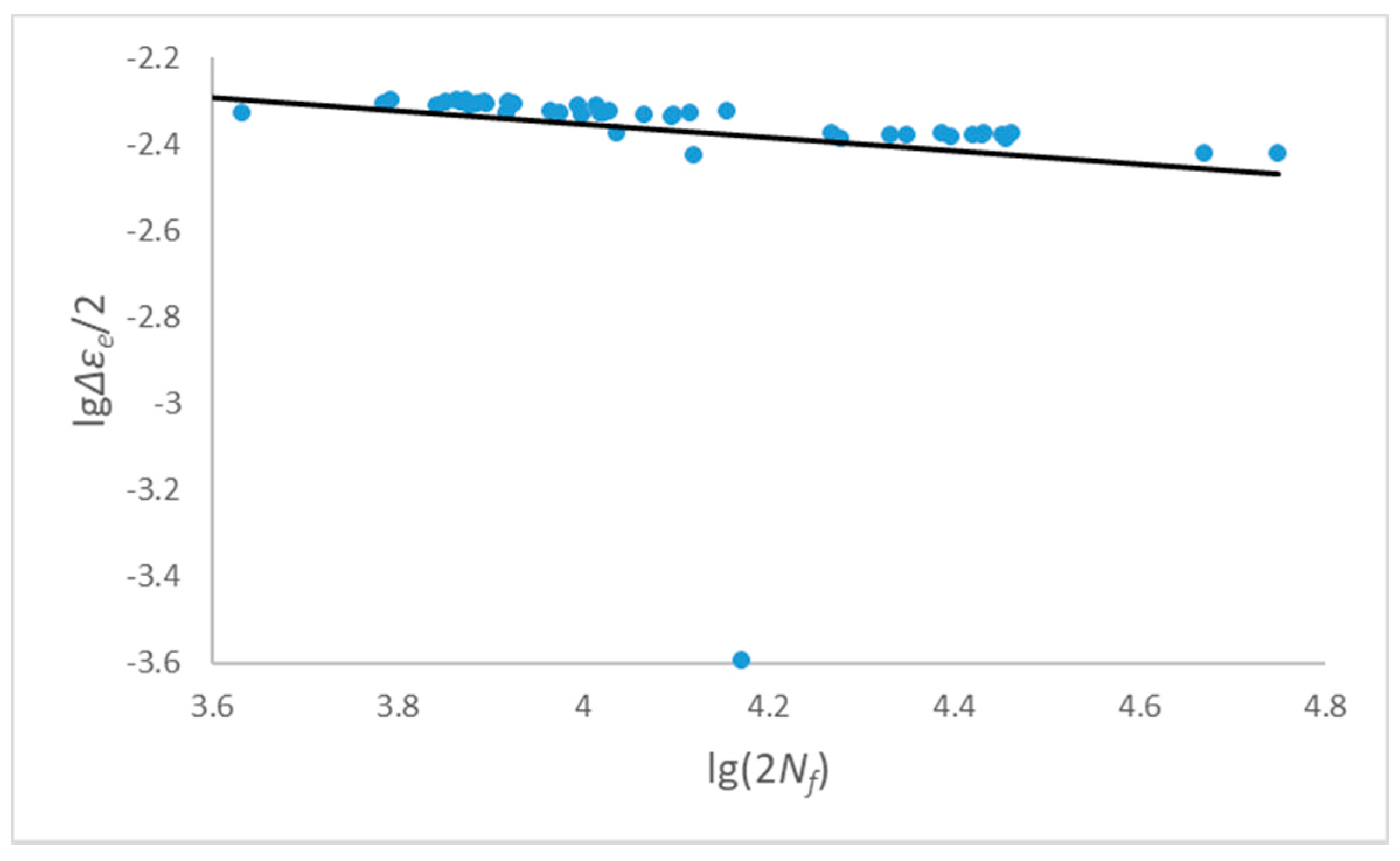
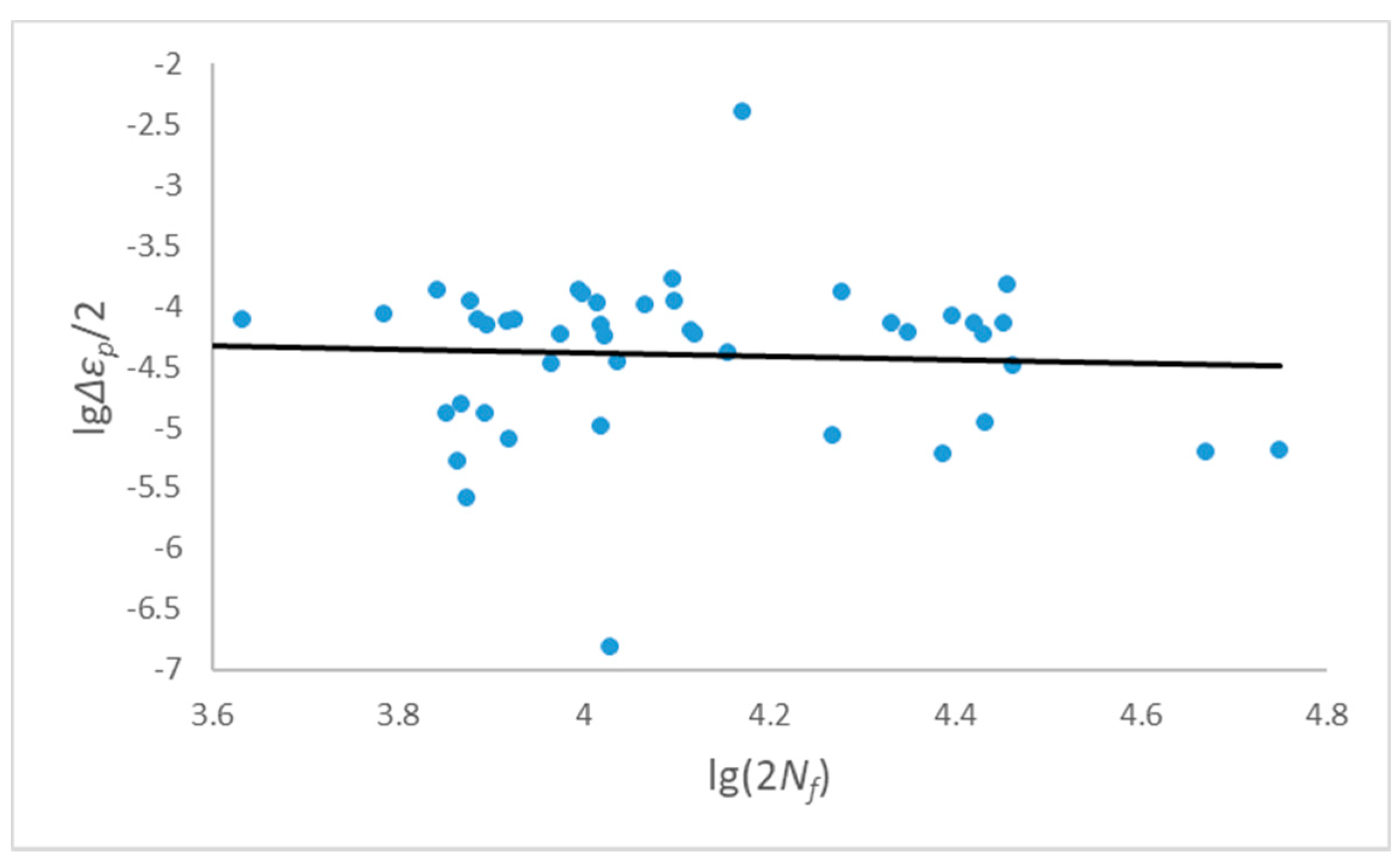

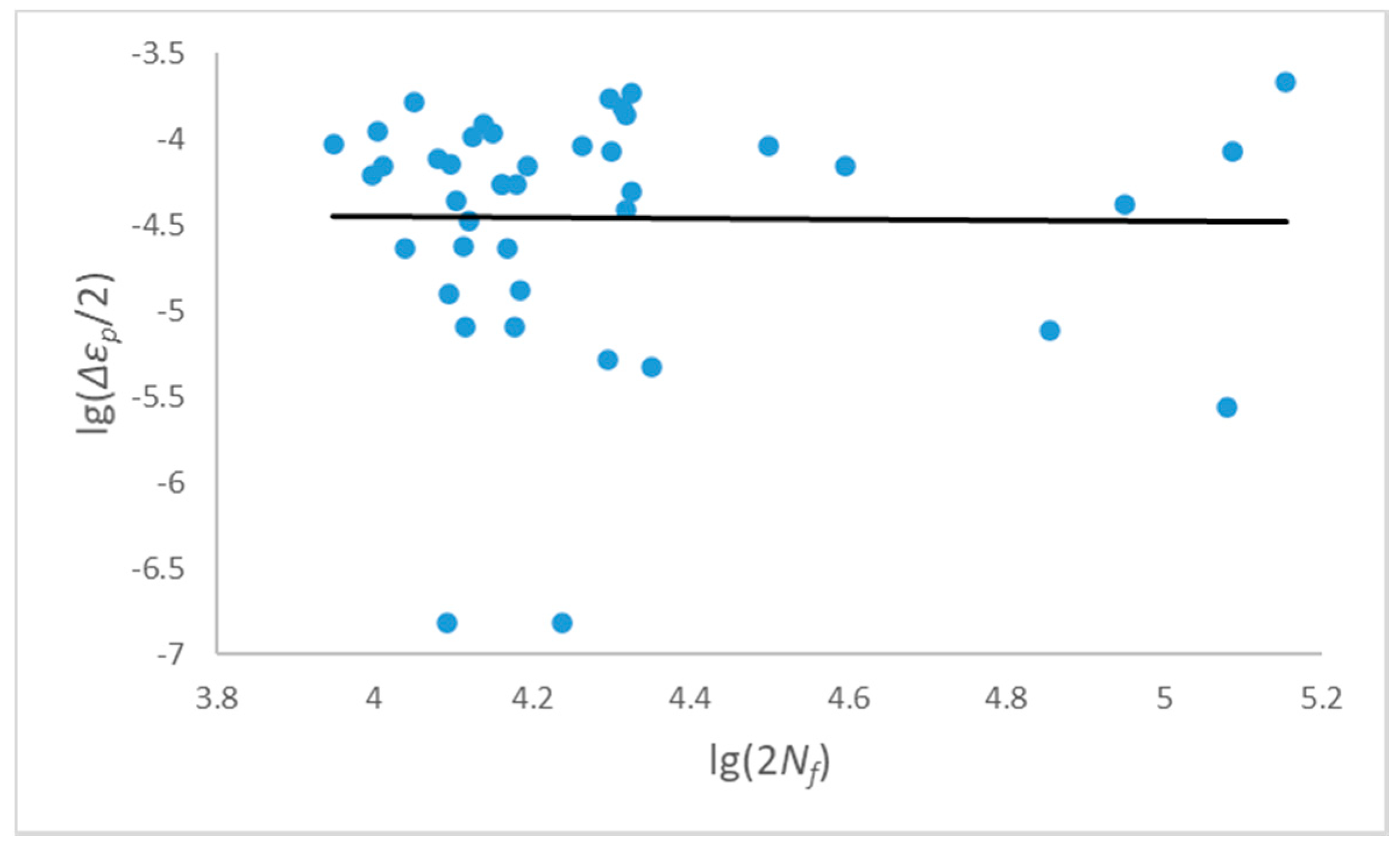

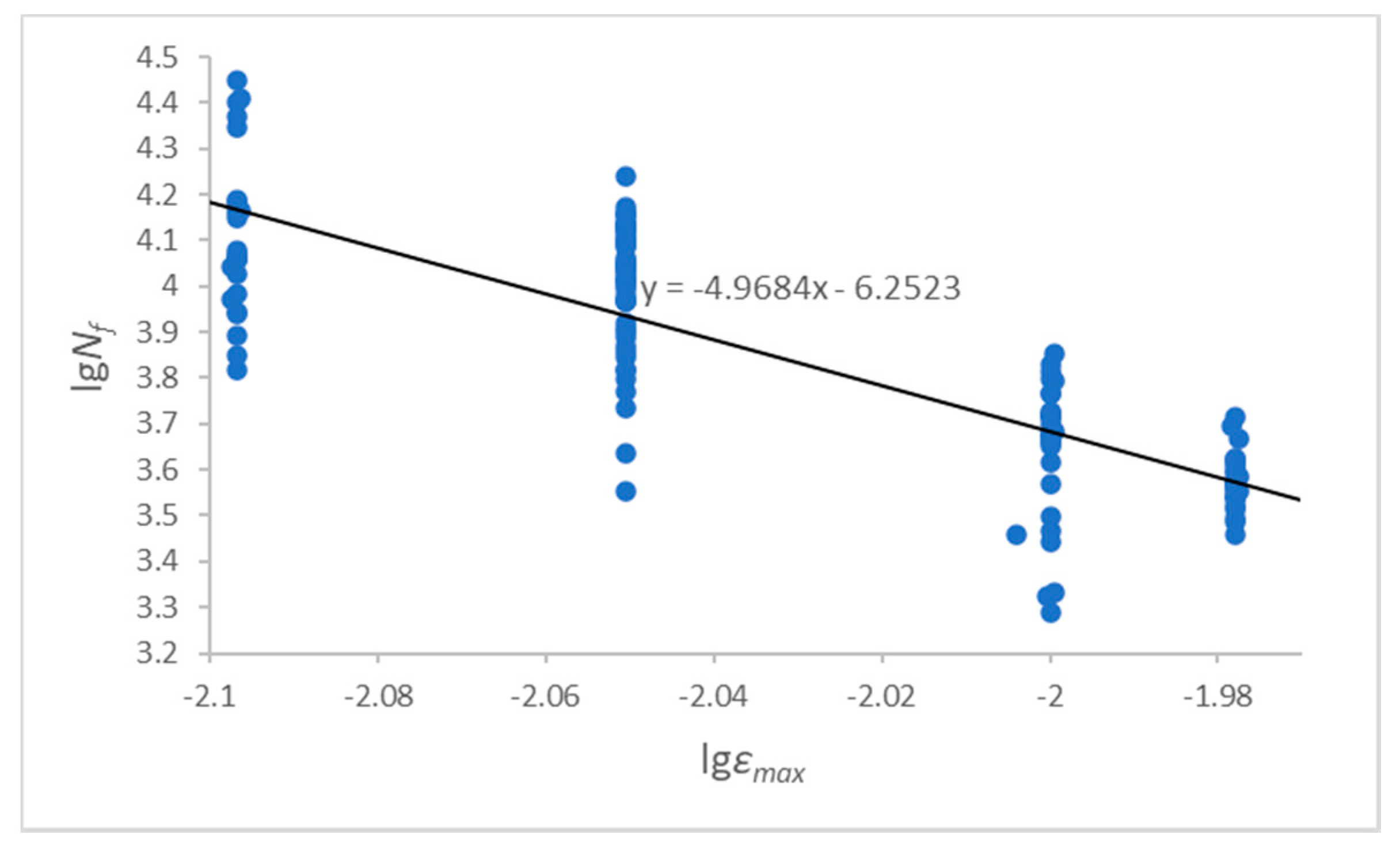


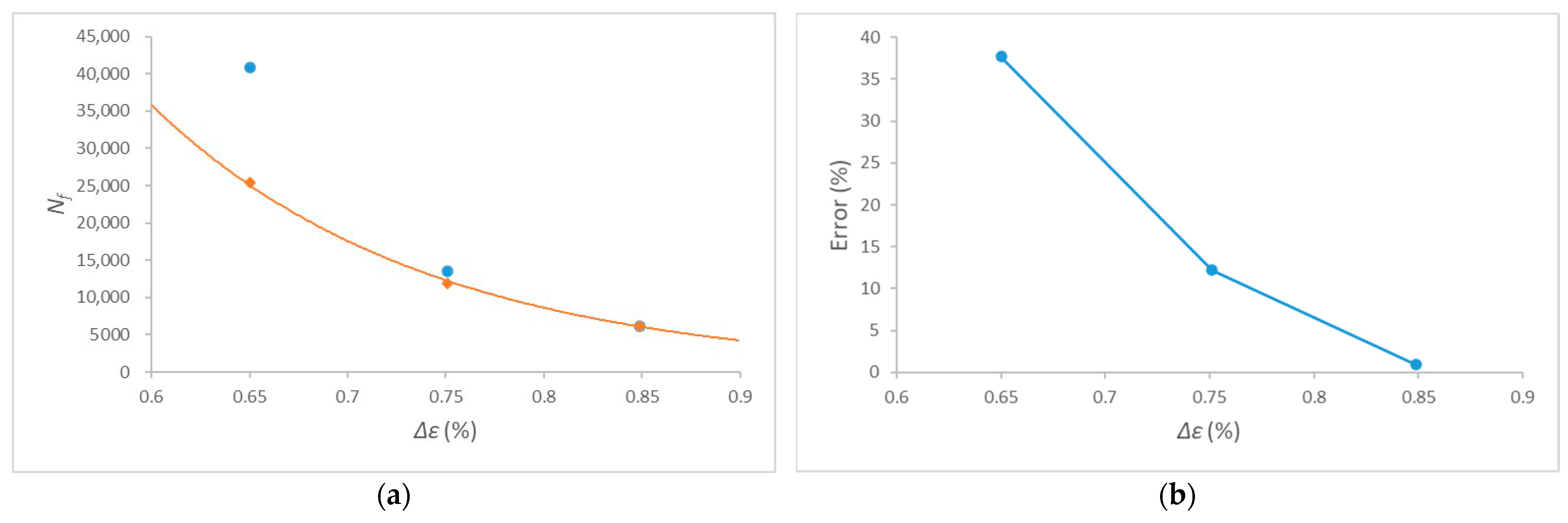
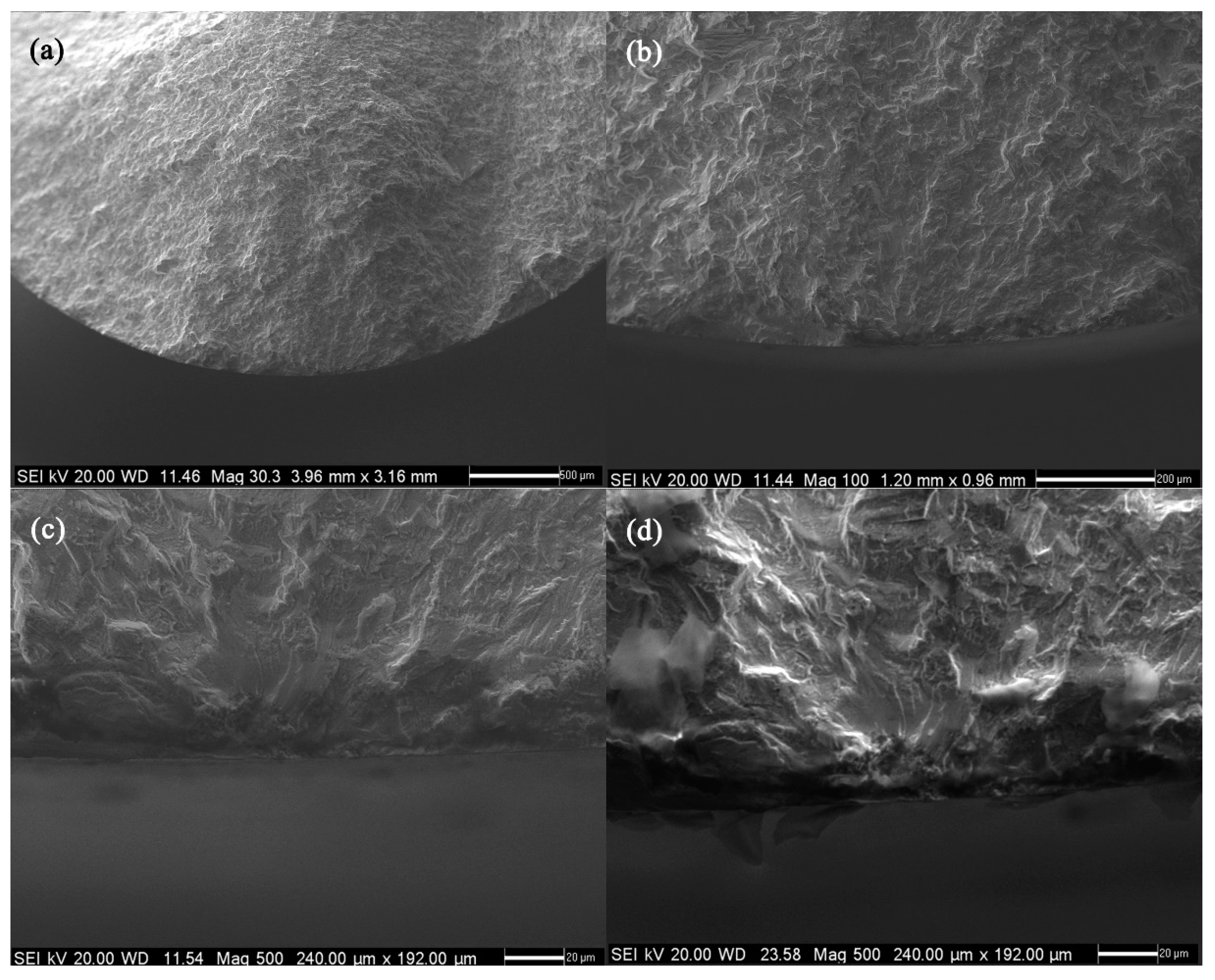

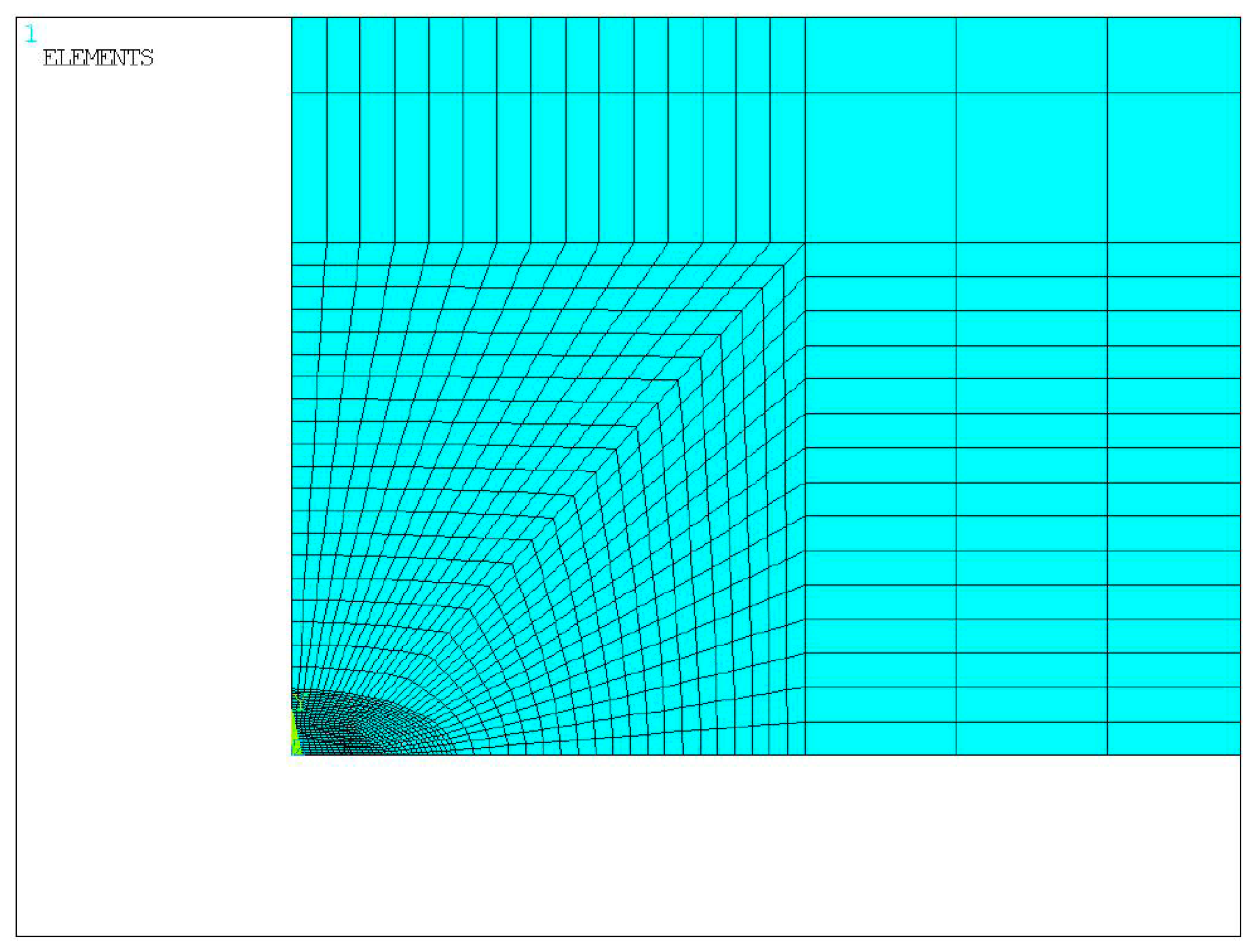
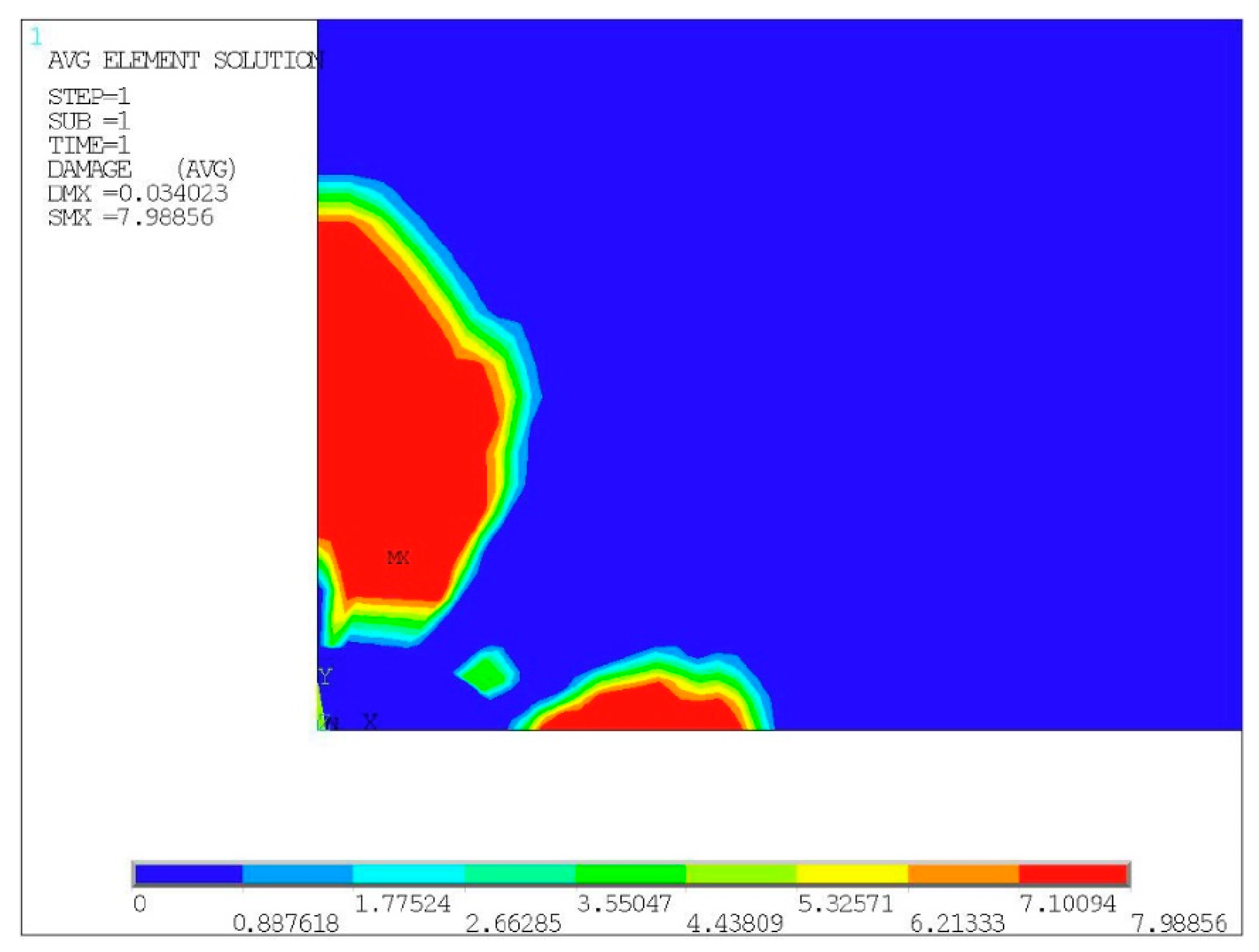
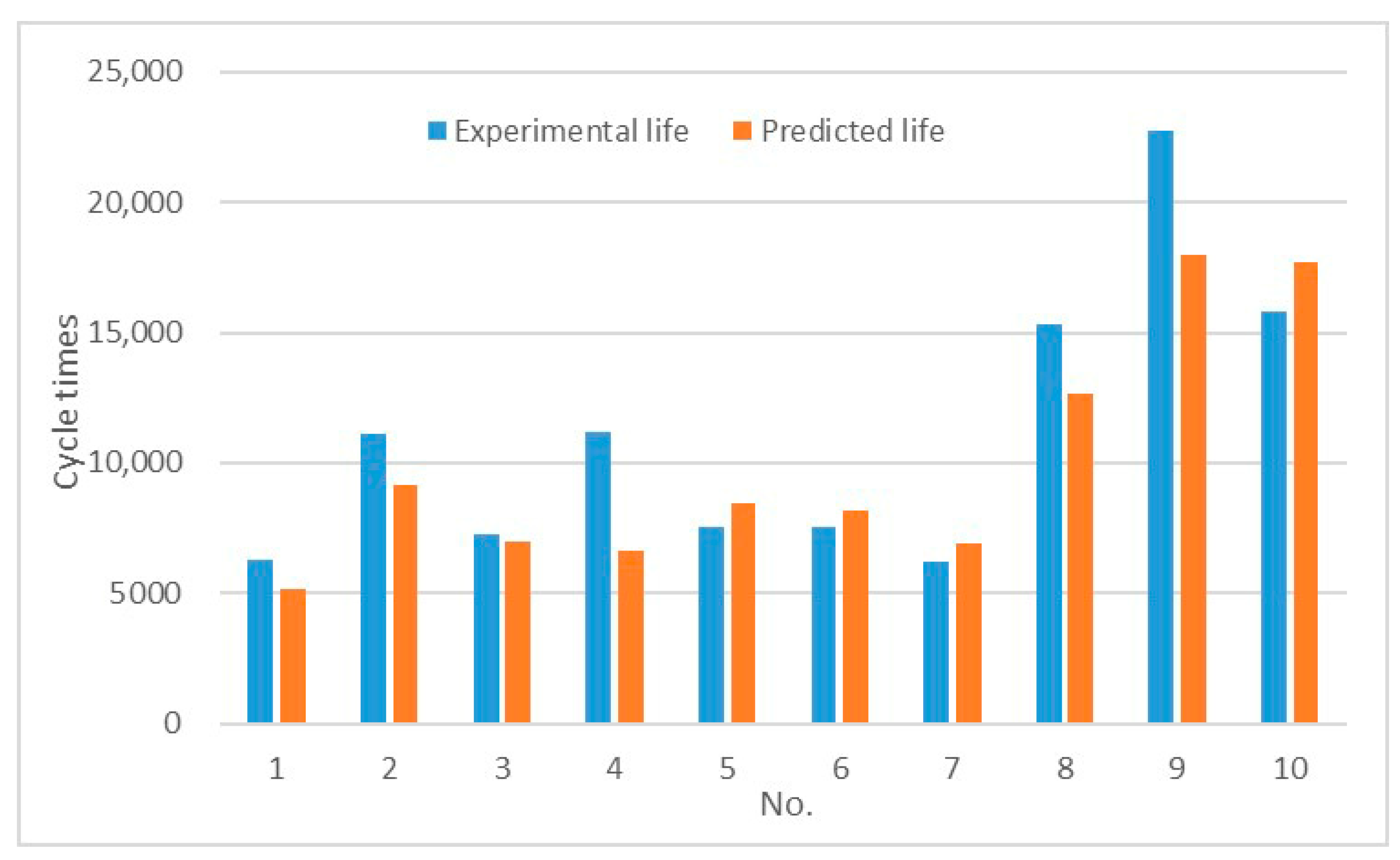
| Experimental Temperature (°C) | Specimen Shape | Load Waveform | Experimental Frequency (Hz) | Strain Ratio |
|---|---|---|---|---|
| 530 | Equal section cylinder | Triangular waveform | 0.33 | 0.05 |
| b | c | ||
|---|---|---|---|
| 0.0182 | −0.1536 | 1.5425 × 10−4 | −0.1430 |
| Experimental Temperature (°C) | Specimen Shape | Load Waveform | Experimental Frequency (Hz) | Strain Ratio |
|---|---|---|---|---|
| 600 | Equal section cylinder | Triangular waveform | 0.33 | 0.2 |
| b | c | ||
|---|---|---|---|
| 0.0084 | −0.0821 | 4.638× 10−5 | −0.0287 |
| No. | Strain Range/% | Experimental Life | Source Morphology | 2 a/μm | 2 c/μm | Predicted Life | Error/% |
|---|---|---|---|---|---|---|---|
| 1 | 0.76 | 7064 | Triangle | 206 | 48 | 14,273 | 102.05 |
| 2 | 0.76 | 15,332 | Semi-ellipse | 70 | 38 | 14,273 | 6.9006 |
| 3 | 0.76 | 9584 | Ellipse | 33 | 27 | 14,273 | 48.946 |
| 4 | 0.76 | 7801 | Polygon | 128 | 93 | 14,273 | 83.002 |
| 5 | 0.76 | 6595 | Quadrilateral | 61 | 58 | 14,273 | 116.48 |
| 6 | 0.85 | 8125 | Triangle | 64 | 77 | 7099 | 12.628 |
| 7 | 0.85 | 7771 | Polygon | 50 | 53 | 7099 | 8.6347 |
| 8 | 0.85 | 11,116 | Triangle | 72 | 23 | 7099 | 36.119 |
| 9 | 0.85 | 9246 | Quadrilateral | 123 | 95 | 7099 | 23.188 |
| 10 | 0.85 | 12,249 | Long strip | 168 | 49 | 7099 | 42.012 |
| 11 | 0.95 | 3142 | Ellipse | 61 | 63 | 3336 | 6.1744 |
| 12 | 0.95 | 5210 | Polygon | 60 | 49 | 3336 | 35.950 |
| 13 | 0.95 | 4823 | Long strip | 13 | 87 | 3336 | 30.790 |
| 14 | 0.95 | 4490 | Polygon | 48 | 66 | 3336 | 25.325 |
| 15 | 0.95 | 4610 | Semi-ellipse | 44 | 29 | 3336 | 27.549 |
| Strain Ratio R | Strain Range (%) | Experimental Life | Predicted Life | Error (%) |
|---|---|---|---|---|
| 0.05 | 0.76 | 14,031 | 14,655 | 4.45 |
| 0.85 | 10,371 | 8604 | 17.04 | |
| 0.95 | 4630 | 4836 | 4.44 | |
| 1 | 3790 | 3748 | 1.12 |
| Strain Ratio R | Strain Range (%) | Experimental Life | Predicted Life | Error (%) |
|---|---|---|---|---|
| 0.2 | 0.65 | 40,838 | 25,448 | 37.69 |
| 0.751 | 13,526 | 11,879 | 12.18 | |
| 0.849 | 6126 | 6181 | 0.90 |
| No. | Strain Ratio | Strain Range/% | Experimental Life | Diameter/mm | Main Component of Defect | Inclusion Shape | 2a/μm | 2c/μm | Distance Defect & Surface/mm |
|---|---|---|---|---|---|---|---|---|---|
| 53 | 0.05 | 0.846 | 7247 | 6 | TiO | Semi-ellipse | 64 | 26 | 0 |
| Elements | Mass Percentage | Atomic Percentage |
|---|---|---|
| C K | 36.26 | 56.22 |
| O K | 25.36 | 29.51 |
| Al K | 3.61 | 2.49 |
| Ti K | 19.72 | 7.66 |
| Cr K | 3.10 | 1.11 |
| Co K | 1.46 | 0.46 |
| Ni K | 5.29 | 1.68 |
| Nb K | 3.37 | 0.67 |
| W M | 1.84 | 0.19 |
| Total | 100.0 |
| No. | Inclusion Shape | 2a/μm | 2c/μm | Distance Defect & Surface/mm | Experimental Life | Ymax | Predicted Life | Error (%) |
|---|---|---|---|---|---|---|---|---|
| 1 | Ellipse | 102 | 54 | 0 | 6276 | 9.013 | 5179 | 17.48 |
| 2 | Long strip | 13 | 87 | 0.047 | 11,116 | 7.166 | 9157 | 17.62 |
| 3 | Semi-ellipse | 64 | 26 | 0 | 7247 | 7.989 | 6990 | 3.55 |
| 4 | Ellipse | 45 | 40 | 0.037 | 11,188 | 8.171 | 6608 | 40.93 |
| 5 | Polygon | 68 | 70 | 0.042 | 7540 | 8.984 | 8422 | 11.70 |
| 6 | Long strip | 26 | 34 | 0.038 | 7546 | 9.078 | 8191 | 8.55 |
| 7 | Semi-ellipse | 85 | 74 | 0 | 6244 | 9.679 | 6919 | 10.81 |
| 8 | Polygon | 50 | 50 | 0.045 | 15,332 | 6.290 | 12,659 | 17.43 |
| 9 | Polygon | 45 | 65 | 0 | 22,738 | 6.740 | 17,970 | 20.97 |
| 10 | Semi-ellipse | 46 | 73 | 0 | 15,806 | 6.783 | 17,671 | 11.80 |
Publisher’s Note: MDPI stays neutral with regard to jurisdictional claims in published maps and institutional affiliations. |
© 2021 by the authors. Licensee MDPI, Basel, Switzerland. This article is an open access article distributed under the terms and conditions of the Creative Commons Attribution (CC BY) license (http://creativecommons.org/licenses/by/4.0/).
Share and Cite
Xu, Y.; Chen, H.; Zhang, S.; He, T.; Liu, X.; Chang, X. An Experimental Study on Low-Cycle Fatigue Crack Initiation Life Prediction of Powder Superalloy FGH96 Based on the Manson-Coffin and Damage Mechanics Methods. Metals 2021, 11, 489. https://doi.org/10.3390/met11030489
Xu Y, Chen H, Zhang S, He T, Liu X, Chang X. An Experimental Study on Low-Cycle Fatigue Crack Initiation Life Prediction of Powder Superalloy FGH96 Based on the Manson-Coffin and Damage Mechanics Methods. Metals. 2021; 11(3):489. https://doi.org/10.3390/met11030489
Chicago/Turabian StyleXu, Yuanming, Hao Chen, Shuming Zhang, Tianpeng He, Xuerong Liu, and Xiayuan Chang. 2021. "An Experimental Study on Low-Cycle Fatigue Crack Initiation Life Prediction of Powder Superalloy FGH96 Based on the Manson-Coffin and Damage Mechanics Methods" Metals 11, no. 3: 489. https://doi.org/10.3390/met11030489
APA StyleXu, Y., Chen, H., Zhang, S., He, T., Liu, X., & Chang, X. (2021). An Experimental Study on Low-Cycle Fatigue Crack Initiation Life Prediction of Powder Superalloy FGH96 Based on the Manson-Coffin and Damage Mechanics Methods. Metals, 11(3), 489. https://doi.org/10.3390/met11030489






